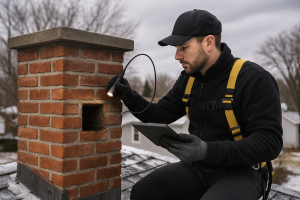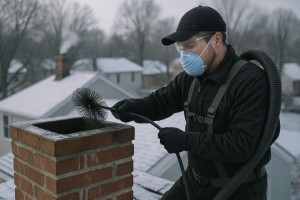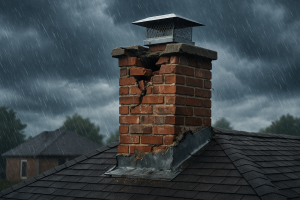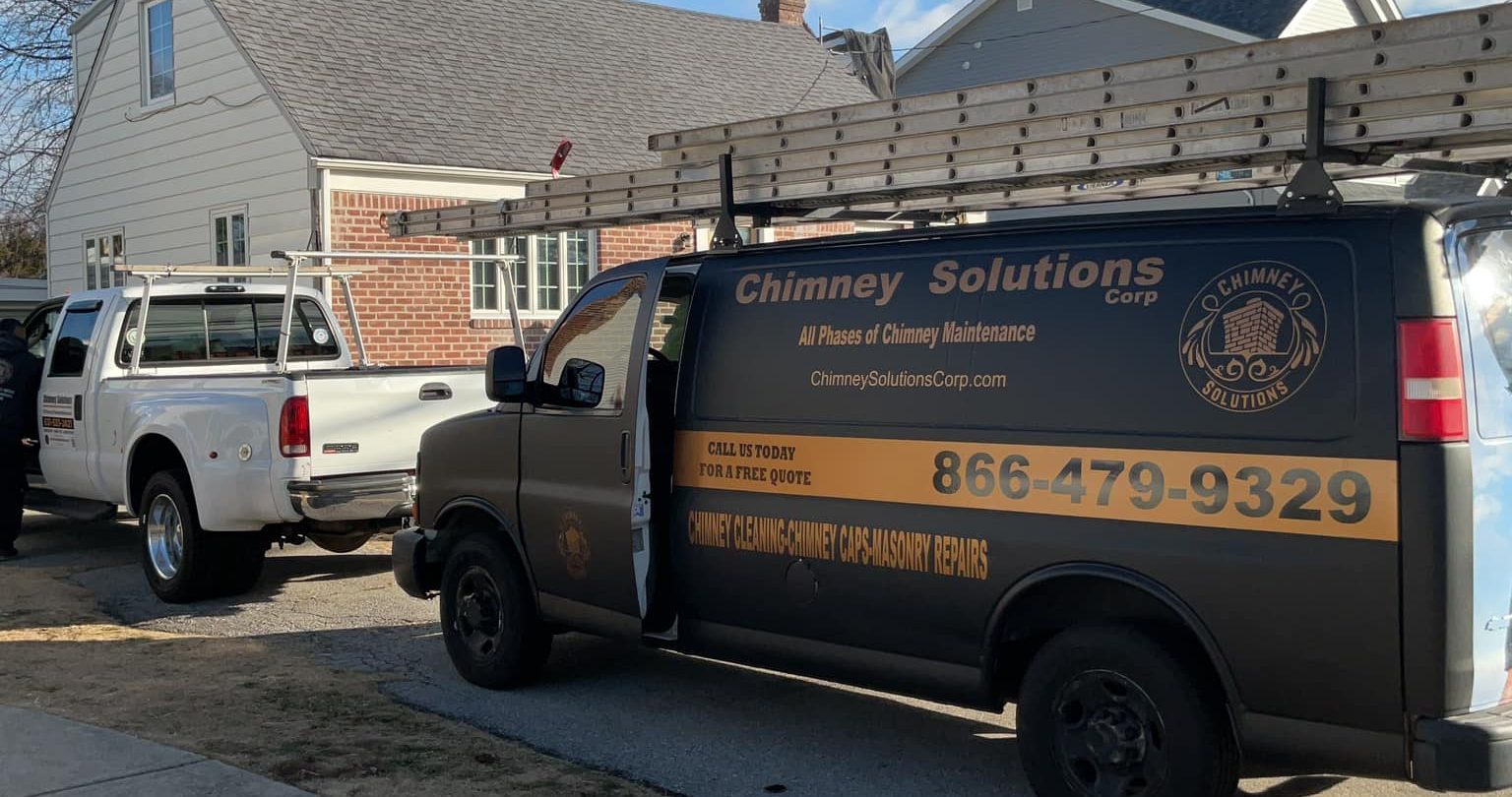The Importance of Chimney Fans for Proper Ventilation in Commercial Properties
New York City’s skyline is adorned with a myriad of commercial buildings, each equipped with complex mechanical systems that ensure safety and efficiency. Among these systems, the chimney plays a pivotal role, especially in structures utilizing heating appliances. However, an often-overlooked component of the chimney system is the chimney cap. This seemingly minor addition serves as a crucial protective barrier for chimney flues, safeguarding against water infiltration, animal intrusion, draft issues, and costly repairs. In the bustling urban environment of NYC, where buildings are subject to stringent codes and unpredictable weather, the importance of chimney caps cannot be overstated. This article delves into the necessity of chimney caps for commercial properties in NYC, highlighting their role in compliance, safety, and maintenance.
The Role of Chimney Caps in Commercial Chimney Systems
Chimney caps are installed at the top of chimney flues, acting as a shield against external elements. For commercial buildings, which often feature factory-built, masonry, or exterior metal chimneys, chimney caps are indispensable. They prevent debris, animals, and precipitation from entering the flue, support optimal performance of draft systems, and reduce the likelihood of corrosive action due to moisture or chemicals. Moreover, they help maintain the structural integrity of the chimney and connected systems. According to the NYC Mechanical Code Chapter 8, all chimneys must have terminations that protect against weather and downdrafts. Commercial properties lacking caps may be in violation of these codes, leading to permit violations or costly maintenance. NYC Mechanical Code Chapter 8
NYC Building Code Requirements for Chimney Terminations
The NYC Department of Buildings (DOB) mandates that all chimneys, particularly in multi-family or three-family buildings, adhere to strict termination standards. Chimney caps must meet ASTM E2336 and ASTM C 315 performance standards, be installed to prevent penetrating smoke, draft backflow, and water infiltration, and are often mandatory for any limited alteration application involving mechanical draft systems. Property owners can reference the DOB NOW portal or NYC Administrative Code for specific project filing instructions and compliance details. Non-compliance may result in permit status issues or necessitate the removal and re-permitting of non-compliant systems. DOB NOW Portal NYC Administrative Code – Chimneys
Water Damage: A Silent Chimney Killer
Without a chimney cap, rainwater and melting snow can easily infiltrate the chimney flue. Over time, this moisture combines with soot and creosote, creating acidic byproducts that accelerate the deterioration of noncombustible materials, lead to internal corrosive action in factory-built chimneys, and cause freeze-thaw cycles in masonry chimneys, resulting in spalling and structural breakdown. These issues are not merely theoretical; they are significant contributors to expensive repairs. As noted by Chimney Solutions Corp, capped chimneys have a longer lifespan and are less likely to require costly restoration. Chimney Solutions Corp – Chimney Caps
Preventing Animal Intrusion and Debris Accumulation
Pest intrusion is a leading cause of chimney blockages in NYC. Birds, squirrels, and raccoons often seek shelter in open flues, building nests that obstruct airflow and increase carbon monoxide risks for occupants. Chimney caps equipped with mesh screens are designed to prevent wildlife from entering the system, reduce blockages from leaves and debris, eliminate erratic draft system behavior, especially in windy conditions, and mitigate problems with mechanical draft systems and direct-vent terminations. For large properties with multiple flues or shared horizontal terminations, the risk of debris-related blockage is significantly heightened, making chimney caps essential.
Enhancing Fire and Smoke Safety
In commercial buildings where multiple units may utilize fireplaces or solid fuel-burning appliances, proper ventilation is critical. Without a chimney cap, sparks and embers can escape, posing a risk of rooftop fires. Poor airflow may allow products of combustion or smoke to backdraft into occupied spaces, and unlisted chimneys can become serious safety hazards. Chimney caps help maintain safe draft system functionality and reduce the risk of thermal conductivity failure, which is crucial for protecting rooftop mechanical systems and adjacent buildings.
Boosting Energy Efficiency and System Performance
Chimney caps contribute to energy efficiency by preventing downdrafts, which reduces strain on internal combustion engines and heating systems, and by helping regulate airflow, thereby minimizing fuel consumption. They also insulate against temperature loss at the flue termination. For buildings utilizing battery backup, mechanical systems, or medium-heat appliances, this improved thermal performance is particularly valuable. Chimney caps enable these systems to function with proper operation, even during extreme cold or wind conditions.
Cost Savings Through Preventative Maintenance
While a chimney cap may appear to be a minor investment, its long-term value is substantial. By preventing moisture, debris, and animals from entering the chimney, caps reduce the need for annual emergency inspections, flue repairs due to corrosion or blockages, and expensive roof or parapet wall repairs caused by leaks. Caps installed during routine chimney inspections can reduce service calls by up to 40%, which is especially impactful for commercial owners managing multiple properties.
Selecting the Right Chimney Cap for Your Property
There are several types of chimney caps available to meet the unique needs of NYC buildings. Single-flue caps made of stainless steel are suitable for small buildings with single chimneys and are the most affordable option. Multi-flue caps, constructed from copper or steel, are ideal for multiple flues or custom chimneys and offer enhanced weather resistance. Integral vent caps, typically made of galvanized steel, are designed for venting appliances and are built to accommodate venting systems. Custom-made caps can be crafted from various materials to match the aesthetic of historic or finished-grade buildings. High-rise buildings often require vertical terminations capable of withstanding high wind speeds. For these installations, a professional engineer or plan examiner should review specifications and complete plans.
Navigating NYC-Specific Considerations: Historic Buildings and Permits
In areas like Staten Island, Manhattan, and Brooklyn, many commercial properties are designated as historic buildings, introducing additional challenges such as maintaining aesthetics during chimney cap installation, filing additional permits with the Department of Buildings, and coordinating inspections with city planners and historical preservation societies. In such cases, it’s crucial to work with experienced design professionals who can handle installation instructions, coordinate with inspectors, and prevent permit violations. For more information on NYC’s permitting process, refer to the NYC DOB Technical Reports Guide. NYC DOB Technical Reports Guide
Partnering with Qualified Chimney Experts in NYC
Selecting a qualified provider is essential when evaluating a chimney cap installation service. Look for companies with proven experience in commercial chimney systems, familiarity with NYC code and permitting requirements, use of ASTM-approved materials, and maintenance plans that include regular inspections. Chimney Solutions Corp is NYC-based providers specializing in commercial chimney maintenance, inspections, and cap installations. Chimney Solutions offers licensed services and prioritize compliance.
The Importance of Routine Chimney Inspections for Commercial Buildings
Regular Chimney Inspection Services are critical for ensuring that commercial chimney systems in NYC remain compliant, efficient, and safe. Unlike residential inspections, commercial evaluations must account for building characteristics, multiple chimney connectors, and the presence of solid fuel-burning appliances. Inspections ensure proper draft operation, check for signs of moisture damage or flue obstruction, and confirm that the chimney outlet, integral venting, and masonry chimneysshall operate within expected performance thresholds.
A clean chimney improves efficiency and significantly reduces fire risks. Partnering with certified professionals ensures access to a wide range of services that meet both DOB and FDNY requirements.
Fire-Resistance, Smoke Safety, and Code Compliance
Modern chimney systems must support safe operation across a range of building layouts and materials. NYC commercial properties often require fire-resistance-rated wall assemblies, particularly when a wall pass-through system is used to connect appliances across rooms or floors. These pass-through systems must also consider structural framing, adjacent roof structures, and interior building wiring.
Beyond passive fire protection, modern chimneys must also mitigate risks from smoke bombs, smoke machines, and natural products of combustion that can accumulate in high-traffic areas. Proper installation of smoke detectors near chimney exits and vents can provide audible warning in case of a draft failure or blockage.
Compliance with mechanical codes such as 804.3.8 Mechanical Draft Systems and Mechanical Draft Systems804.1 Direct-Vent TerminationsVentterminals ensures the pressure during operation shall remain within safe limits. Non-compliance with these codes can void warranties, result in fines, and cause operational hazards.
Common Venting System Failures and How Chimney Caps Help Prevent Them
Aging or improperly installed chimneys often suffer from compromised venting systems. Whether it’s due to horizontal terminations, vertical terminations, or roof ridge wind turbulence, chimneys without caps experience inconsistent airflow, leading to performance issues and even fire risks.
For example, Medium-Heat Appliances and Factory-built chimneys for medium-heat appliances producing flue gases must be installed in accordance with 2)805.1 ListingFactory-built chimneysshall codes. Without proper venting relief equipment or insulation material, the temperature differentials and backdraft risks increase dramatically.
Chimney caps, when paired with proper draft designs, support the long-term performance of these systems by reducing thermal loss, regulating air pressure, and preventing debris blockages at key transition points like the chimney outlet or pass-through system.
Permits, Inspections & Filing Challenges Unique to NYC
NYC’s permitting process can be complex—particularly for commercial properties, 3-family buildings, or structures with older systems. Business owners may need to navigate multiple documentation steps, including:
- Electrical application reviews for buildings with integrated HVAC or chimney automation
- Elevator permit overlap for chimneys near vertical lift zones
- Composite permit filing when combining mechanical, structural, and masonry repairs
- Obtaining a Permit Entire for full chimney rebuilds or extensive modifications
- Submitting a Preliminary Commissioning Report when installing factory-built or high-efficiency draft systems
Working with experienced professionals helps prevent delays due to misfiled applications, incorrect step instructions, or failures to meet newer ASTM standards such as ASTM E2816 for heat and smoke resistance.
Integrating Chimney Cap Maintenance into Your Long-Term Building Strategy
Property managers should integrate chimney cap maintenance into broader facility management plans. This includes coordinating with roofing inspections, HVAC maintenance, and facade cleaning schedules. Caps located near a roof ridge or in close proximity to other structures must be checked more frequently due to wind turbulence and runoff exposure.
Incorporating chimney inspection reports into your building owner’s annual audit helps highlight preventative opportunities, such as replacing aging caps before they corrode or deteriorate. Maintaining compliance across multiple systems also ensures reduced liability and helps preserve your property’s long-term value.
Conclusion: Safeguard Your Property with a Chimney Cap
For NYC property owners, neglecting to install a chimney cap is not only risky but also a direct path to expensive repairs, potential violations, and safety hazards. Given the city’s strict codes, harsh weather conditions, and high-density construction, chimney caps provide a vital layer of protection for both the structure and its occupants. Whether managing a factory-built chimney, a masonry system, or a high-rise building with multiple units, a chimney cap is a simple, cost-effective solution to prevent water and draft issues, ensure compliance with NYC mechanical codes, boost energy efficiency, and extend the lifespan of your chimney and HVAC systems. Trust Chimney Solutions to help you stay ahead of costly issues. From expert inspections to custom chimney cap installations, we offer the essential services that NYC commercial buildings rely on. Contact us today to schedule your inspection and ensure your chimney operates safely and efficiently.



